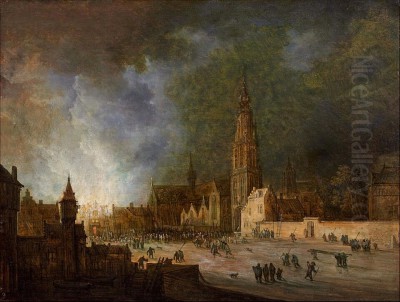
Frans de Momper (1603–1660) stands as a significant, albeit sometimes overlooked, figure in the rich tapestry of Flemish Baroque art. Born in the bustling artistic hub of Antwerp, he dedicated his career primarily to landscape painting and printmaking, navigating the stylistic shifts of the early to mid-17th century. His life and work connect the established traditions of Flemish landscape with the emerging trends both in his native Southern Netherlands and in the Dutch Republic to the north.
Antwerp Beginnings and Family Ties
Frans de Momper was born into an environment steeped in artistic creation. His father, Bartolomeus de Momper, was recognized as an artist and engraver, establishing an artistic lineage. However, the most formative familial connection was with his uncle, the highly renowned landscape painter Joos de Momper the Younger (or II). This relationship was pivotal; Frans is widely considered to have been a pupil of his famous uncle, absorbing the techniques and compositional strategies that characterized the elder Momper's output.
Evidence suggests Frans followed the traditional path for Antwerp artists. He honed his skills likely within his uncle's workshop, surrounded by the dynamic artistic production of the city. His formal entry into the professional art world came in 1629 when he was registered as a master in the prestigious Antwerp Guild of Saint Luke. This membership conferred upon him the right to establish his own workshop, take on pupils, and sell his works independently, marking a crucial step in his career.
Travels and Work in the Netherlands
While rooted in Antwerp, Frans de Momper's career path led him northward to the Dutch Republic for a significant period, likely spanning about two decades starting around the late 1640s. This move exposed him to different artistic currents and patronage systems. Records place him initially in The Hague in 1647, a center of political power and aristocratic patronage.
His journey continued, and by 1648, he was documented working in Haarlem. Haarlem was a particularly vibrant center for landscape painting during this period, home to innovators like Esaias van de Velde, Jan van Goyen, and Salomon van Ruysdael. Exposure to their tonal approaches and emphasis on local scenery may have further influenced de Momper's evolving style.
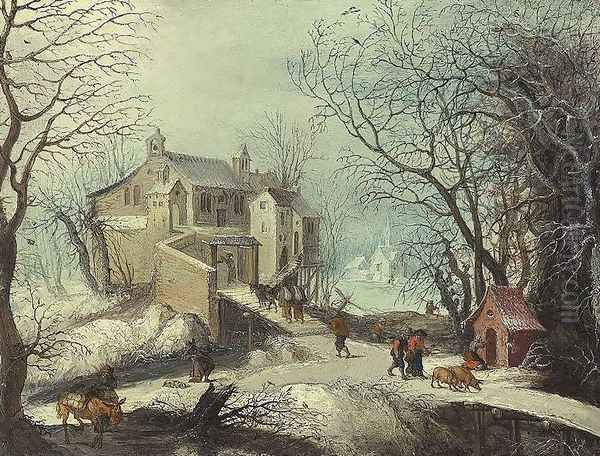
In 1649, Frans de Momper was in Amsterdam, the booming commercial and cultural heart of the Dutch Republic, where he married. This period in the Northern Netherlands was likely formative, allowing him to absorb and react to the distinct developments in Dutch landscape painting, which often favored more naturalistic depictions and atmospheric effects compared to the sometimes more fantastical elements seen in earlier Flemish work. Despite this extended stay, he eventually returned to his native city, being documented back in Antwerp by 1650, where he continued his artistic practice until his death in 1660.
Artistic Style: Bridging Traditions
Frans de Momper's artistic style is fascinating for its position between older traditions and newer developments. His early work, unsurprisingly, shows the strong imprint of his uncle, Joos de Momper II. This is evident in his adoption of the panoramic or "world landscape" perspective, often featuring elevated viewpoints, winding paths leading the eye into the distance, and dramatic, sometimes fantastical mountain formations. The influence extended to technique, including certain palettes and brushwork.
However, Frans developed his own distinct artistic voice. While Joos II often employed a Mannerist palette with distinct color bands for foreground, middle ground, and background (typically brown, green, blue), Frans moved towards a more unified tonal approach, particularly evident in his use of monochromatic palettes, often favoring browns and grays. This shift aligned him with contemporary trends in both Flemish and Dutch "tonal landscape" painting, associated with artists like Jan van Goyen.
His landscapes are often characterized by a sense of tranquility and a subtle rendering of atmosphere. Art historians note the "deep brown tones," a certain "glossiness," a "linear feel in the air," skillful "color effects," and an overall "poetic" quality achieved through "clever execution." Compared to the sometimes dramatic energy of his uncle's work, Frans's paintings can feel more subdued and introspective, using deeper, more resonant colors and often simpler, more focused compositions to convey emotion.
He effectively navigated the transition from the late Mannerist tendencies, seen in the work of artists like his uncle and Paul Bril, towards the greater naturalism and atmospheric focus that would define much of 17th-century Baroque landscape painting. He could employ both the high-viewpoint, somewhat imaginary compositions reminiscent of the tradition stemming from Pieter Bruegel the Elder, and also create more realistic, low-viewpoint scenes that feel grounded in observable reality, reflecting the typical landscapes of the Low Countries.
Key Themes and Subjects
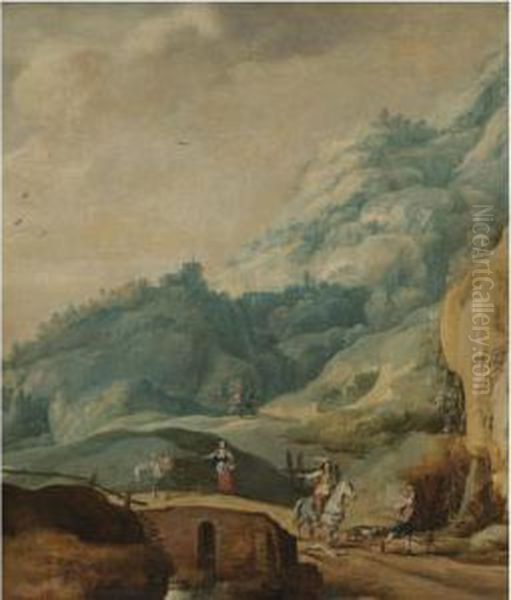
Landscape was the dominant genre for Frans de Momper. His oeuvre primarily consists of depictions of the natural world, often populated with small figures that provide scale and narrative interest but rarely dominate the scene. He excelled at capturing the breadth of the land, utilizing the panoramic format inherited from his uncle but often imbuing it with a softer, more atmospheric light.
His subjects included rolling hills, valleys, riverscapes, village scenes, and wooded areas, typical of the Flemish and Dutch countryside. He seemed particularly drawn to depicting the changing seasons. Winter landscapes form a notable part of his output, allowing him to explore specific light conditions and atmospheric effects associated with snow and ice. These scenes often feature frozen rivers or canals with skaters and villagers going about their activities, capturing the specific mood of the season.
Whether depicting expansive vistas or more intimate woodland scenes, his focus remained on conveying the character and atmosphere of the landscape itself. The careful handling of light and shadow, the subtle gradations of color, and the skillful composition all contribute to the immersive quality of his work.
Representative Works
Several key works help illustrate Frans de Momper's style and contribution:
Valley with Hills (c. 1640-1650s, Philadelphia Museum of Art): This painting exemplifies his panoramic approach, likely influenced by Joos II, but executed with his characteristic tonal subtlety and atmospheric depth. It showcases his ability to render expansive space while maintaining a cohesive mood.
Winter Landscape (National Gallery Prague): This work is a prime example of his engagement with seasonal themes. Such paintings allowed him to explore the effects of cold light and snow-covered terrain, often incorporating anecdotal details of rural life during winter, a popular subject in both Flemish and Dutch art.
Mountain Landscape (Royal Museums of Fine Arts of Belgium, Brussels): Originally titled Frans de Momper in the Mountains in some sources, this work (likely depicting a generic mountain scene rather than the artist himself) is noted for its specific features: "brown earth and monotonous red walls," with an "even distribution of light" creating a "peaceful, relaxed atmosphere." This description highlights his control over mood through color and light.
The Shepherd (Royal Museums of Fine Arts of Belgium, Brussels): The acquisition of this painting by the Brussels museum in 1936 was significant. Reportedly lacking a signature or date, its attribution to Frans de Momper was established through stylistic comparison with other known works, demonstrating the importance of connoisseurship in studying artists with less extensive documentation.
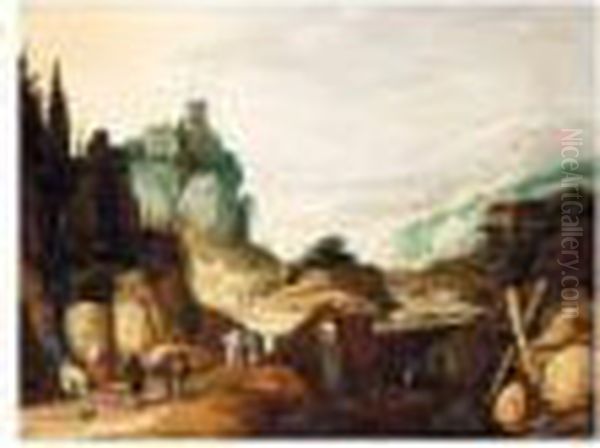
Lively Snowy Landscape (Paysage de neige animé): The notable auction price achieved by this work (€208,724, as mentioned in the source material) attests to the continued appreciation and market value of Frans de Momper's paintings among collectors. It underscores his recognized skill, particularly in rendering animated winter scenes.
These examples showcase his range, from broad panoramas to specific seasonal depictions, all marked by his developing tonal sensitivity and atmospheric concerns.
Collaborations and Artistic Milieu
Collaboration was a common practice in Antwerp's workshops, allowing specialists to combine their skills. While Frans de Momper primarily focused on landscapes, evidence suggests he participated in this system. He is documented as having collaborated with figures from the illustrious Brueghel dynasty, specifically Jan Brueghel the Elder and his son, Jan Brueghel the Younger. In these collaborations, de Momper would likely have painted the landscape settings, while the Brueghels, renowned for their figure painting, would add the staffage (human figures and animals).
His primary artistic relationship remained with his uncle, Joos de Momper II, whose influence is undeniable, particularly in Frans's early career and compositional choices. He operated within a broader artistic context shaped by figures like Pieter Bruegel the Elder, whose innovations in landscape decades earlier still resonated. The influence of artists specializing in fantastical or Italianate landscapes, such as Paul Bril, can also be discerned as part of the background against which Frans developed his style.
Regarding the claim of collaboration with Lodewijk Toeput (also known as Pozzoserrato) on a Seasons series, chronological issues arise. Toeput, active mainly in Italy, died around 1603-1605, precisely when Frans de Momper was born or an infant. It is more likely that Toeput's style, known for its atmospheric qualities and integration of figures in landscapes, was part of the broader artistic influence on the Momper workshop, particularly on Joos II, rather than indicating direct collaboration with Frans.
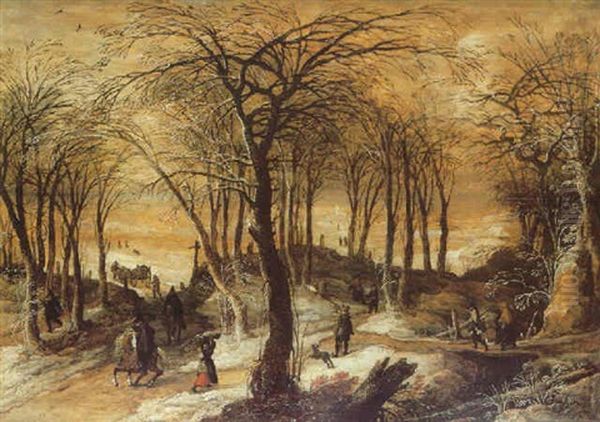
Frans de Momper worked during a period of immense artistic activity. Antwerp, despite political and economic challenges, remained a major center. He would have been aware of the towering figure of Peter Paul Rubens, whose dynamic Baroque style influenced all genres, including landscape, often executed in collaboration with specialists like Jan Wildens and Lucas van Uden. He was also contemporary with genre painters like David Teniers the Younger and Adriaen Brouwer, whose figures often inhabited vividly depicted landscape or rustic settings. In the Northern Netherlands, his contemporaries included the pioneers of tonal landscape Jan van Goyen and Salomon van Ruysdael, whose work offered a different, perhaps more naturalistic, approach to depicting the Dutch environment.
Later Life, Challenges, and Legacy
After returning to Antwerp around 1650, Frans de Momper continued his artistic practice for the last decade of his life. Despite his recognized skill and Guild membership, historical records suggest he faced financial difficulties. A poignant letter of apology regarding debts, addressed to the Archduchess Isabella Clara Eugenia (regent of the Habsburg Netherlands) and forwarded to the Antwerp city council for assistance, provides a glimpse into the precarious economic realities that even established artists could face.
Compared to his prolific uncle, Frans de Momper's known oeuvre is relatively limited. This scarcity means that much of the understanding of his work relies on stylistic analysis and comparison rather than extensive documentation or signed pieces. However, his contribution remains significant. He represents an important link in the evolution of Flemish landscape painting, absorbing the legacy of the 16th century while adapting to the tonal and atmospheric concerns of the 17th century.
His influence extended to subsequent generations. The source material mentions Louis de Coligny (likely referring to Louis de Caulery, known follower or student of Joos de Momper, or perhaps another figure associated with the workshop) as someone who continued his style, indicating a direct pedagogical impact or stylistic following. More broadly, his work contributed to the rich tradition of landscape painting in the Low Countries during the Golden Age. His ability to evoke mood and atmosphere through subtle color harmonies and light effects resonated with the sensibilities of the time and anticipated later developments in landscape art.
Conclusion
Frans de Momper emerges from the shadow of his famous uncle as a distinct artistic personality. A skilled painter and printmaker, he navigated the transition from late Mannerist landscape conventions towards a more naturalistic and atmospheric Baroque style. His time in the Dutch Republic likely broadened his horizons, enriching his inherently Flemish artistic roots. Known for his panoramic views, sensitive handling of color and light, and particularly evocative winter scenes, his work possesses a quiet, poetic quality. Despite facing personal challenges and leaving a relatively small body of work, Frans de Momper holds a secure place in the history of Flemish art, valued for his skillful execution and his role in the evolution of landscape painting during a dynamic period. His paintings continue to be appreciated in museum collections and by private collectors for their tranquil beauty and subtle artistry.